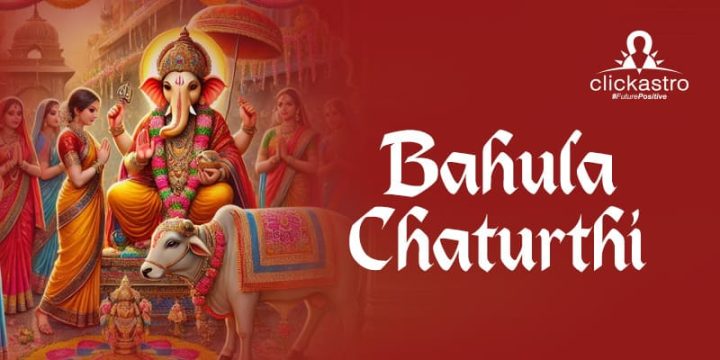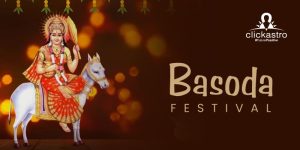Introduction to Bahula Chaturthi
Bahula Chaturthi, also known as Bol Choth, is a revered festival primarily celebrated by the farming community in India. The festival falls in the month of Shravana. It honours cows and calves,l which are considered sacred in Hinduism. Bahula Chaturthi is observed with significant fervour across various parts of India, especially in Gujarat. The festival highlights the essential role cattle play in agricultural communities, symbolizing prosperity and sustenance. During this festival, devotees, particularly women, engage in rituals that express their gratitude and reverence for cows and calves, reflecting the significance of these animals in their lives. By observing fasts, performing prayers, and offering special foods to the cattle, the festival fosters a sense of community and respect for the vital contributions of livestock to their livelihood.
The 2024 Bahula Chaturthi is on Thursday, August 22.
Significance and Traditions
On Bahula Chaturthi, devotees, especially women, worship cows and calves to seek good fortune and prosperity. Here, cows are valued not only for their economic contributions but also for their sacred status. One of the most notable aspects is the ritual abstention from consuming milk and milk products. This symbolizes the respect for calves, acknowledging them as the rightful recipients of their mother’s milk. By refraining from consuming dairy products, devotees emphasize their commitment to the well-being of the calves and the natural bond between them and their mothers.
Additionally, the worship of Lord Krishna, who is closely associated with cows, is a central element of the festival. Known as Govinda or Gopala, which translates to ‘protector of cows,’ Lord Krishna’s devotion to cattle is celebrated through prayers, songs, and the telling of stories from his life that highlight his relationship with cows. Devotees often use images or idols of Krishna, referred to as Suabhis, in their worship, which deepens their spiritual connection and reflects their cultural heritage.
Preparation and Rituals
Morning Preparations
The observance of Bahula Chaturthi begins at the break of dawn. Devotees wake up early to commence the day’s rituals. The first step involves thoroughly washing the cattle sheds and bathing the livestock. This act of cleansing symbolizes deep gratitude and respect for the cows and calves, which are vital to the agricultural cycle. The washing of the cattle and their sheds signifies a fresh start, purifying the space and the animals in preparation for the day’s sacred observances.
Cleaning and Decoration
Following the morning wash, the next ritual involves the meticulous cleaning of the barns where the cattle are housed. This is to create a pure and respectful environment for the worship of these revered animals. The barns are swept and scrubbed, ensuring they are spotless. The devotees engage in decorating their homes and barns with images and idols of Lord Krishna, who is intrinsically linked to cows. They are placed in prominent positions and adorned with kumkum (vermilion) and Chandan (sandalwood paste). Flowers, particularly marigolds, are commonly used to create garlands and intricate rangoli designs at the entrances of homes and barns, inviting divine blessings.
Prayers and Aarti
Devotees gather around the decorated idols of Lord Krishna and other deities to perform aarti. This act of devotion is accompanied by the chanting of hymns and mantras, such as “
Om Namoh Bhagwatey Vasudevaye,” which is recited to seek divine blessings and invoke a sense of spiritual peace and fulfilment. In addition to performing aarti at home, many devotees visit temples dedicated to Lord Vishnu and Lord Krishna. These temples often host special ceremonies and communal prayers, fostering a sense of community among the worshippers. Incense sticks are lit, and offerings of fruits and flowers are made to the deities.
Godhuli Puja
Another highlight of Bahula Chaturthi is the evening ritual known as Godhuli Puja or Gau pooja. As dusk approaches, the time is known as ‘Godhuli’ – which refers to the time when cows return home and dust rises from their hooves – devotees prepare for the
worship of cows and calves. During Godhuli Puja, cows are adorned with flowers and garlands. Devotees apply a tilak of kumkum on the cows’ foreheads, signifying their sacred status. The cows are offered special foods, often made from grains and millet, which are considered a treat for them. This ritual not only highlights the sacredness of the cow in Hindu culture but also reinforces the symbiotic relationship between humans and cattle, emphasizing mutual respect and care.
Additional Rituals and Practices
Apart from the main rituals, Bahula Chaturthi is also marked by several other practices. Devotees often fast throughout the day, abstaining from food and water until the completion of the Godhuli Puja. This fast is seen as an act of penance and devotion, believed to purify the soul and earn divine blessings. Special food items are prepared for the festival. Since milk and dairy products are avoided, the focus is on creating dishes from millet and rice. These foods are not only consumed by the devotees but also offered to the cattle, highlighting the practice of sharing and the interdependence between humans and animals.
Bahula Choth Vrat
Fasting, or Vrat, is a central element of Bahula Chaturthi. On this auspicious day, devotees undertake a rigorous day-long fast, abstaining from consuming any food or water from sunrise until the evening of Godhuli Puja. This fast reflects the devotees’ commitment to purity, discipline, and devotion.
The fast is observed with the belief that it brings divine blessings and good fortune. It is a form of penance, symbolizing their willingness to sacrifice and purify their minds and bodies in honour of the sacred cows and calves. By fasting, devotees seek to cleanse themselves of negative energies and invite positive vibrations into their lives.
During the fast, devotees engage in various spiritual activities such as prayer, meditation, and recitation of sacred hymns. They focus on their devotion to Lord Krishna and the cows.
The fast is broken only after the Godhuli Puja in the evening when devotees offer their prayers to the cows and calves. This breaking of the fast is a moment of joy and fulfilment, marking the culmination of a day dedicated to spiritual practices and devotion.
Special Food Preparations
On Bahula Chaturthi, the preparation of special non-dairy dishes is a significant aspect of the festivities. Devotees prepare meals primarily using millet and rice, which hold both nutritional and cultural importance. This choice of ingredients is deliberate, as it aligns with the day’s practice of abstaining from milk and dairy products to honour the calves, considered the rightful beneficiaries of cow’s milk.
Various rice-based dishes, millet breads, and other grain preparations are made as offerings to the cows. These foods symbolize the devotion and gratitude of the community towards the animals that play an integral role in their agricultural livelihood.
The cooking and consumption of this food often take place outdoors, under the open sky. This fosters a sense of community and adds to the festive spirit of Bahula Chaturthi. Families and neighbours gather together, sharing the responsibility of cooking and enjoying the meal collectively. The outdoor setting also connects the participants more closely with nature, enhancing the celebration’s harmonious and rustic ambience.
The act of preparing and sharing these special foods underscores the festival’s themes of unity, respect for nature, and the sacred relationship between humans and cattle. It is a vibrant manifestation of cultural heritage, bringing communities together in joyous celebration and mutual respect.
Vrat Katha: The Story Behind Bahula Chaturthi
The legend of Bahula Chaturthi centres around a noble cow named Bahula. This tale, deeply embedded in Hindu folklore, encapsulates themes of devotion, integrity, and divine grace.
According to the legend, Bahula was on her way home to feed her hungry calf. As she traversed the forest, she suddenly encountered a fierce lion, poised to attack. Despite her fear, Bahula remained composed and addressed the lion. With heartfelt sincerity, she explained her duty to her calf and requested the lion to allow her to fulfil this maternal obligation. She promised to return to the lion once she had fed her calf.
The lion, struck by Bahula’s devotion and bravery, granted her request. Bahula hurried home, nursed her calf, and, true to her word, returned to face the lion. This act of loyalty and integrity profoundly moved the lion. In awe of her unwavering commitment to her promise and her maternal love, the lion decided to spare her life.
In some versions of the story, it is revealed that the lion was none other than Lord Krishna in disguise. Krishna had taken this form to test Bahula’s devotion and faithfulness. Pleased with her unwavering integrity and the purity of her heart, Krishna revealed his true identity and blessed Bahula. He proclaimed that she would be worshipped on Bhadrapada Chaturthi, a day henceforth known as Bahula Chaturthi.
This story not only highlights Bahula’s virtues but also underscores the festival’s deeper spiritual meaning. It illustrates the values of truthfulness, devotion, and selflessness. By commemorating Bahula Chaturthi, devotees honour these values and express their respect and gratitude towards cows, which are considered embodiments of these noble qualities. The tale of Bahula continues to inspire, reminding people of the profound bond between humans and animals and the virtues that bind them.
Conclusion
Bahula Chaturthi is more than just a festival; it is a celebration of devotion, integrity, and the sacred bond between humans and animals. It highlights the importance of gratitude and respect for the contributions of cattle in the lives of agricultural communities. By abstaining from milk and dairy products, devotees emphasize the calves’ right to their mother’s milk, reinforcing the theme of selflessness and care. As families gather to celebrate Bahula Chaturthi, they not only partake in religious rituals but also strengthen communal ties, reflect on the values of devotion and integrity, and honour the age-old traditions that bind them to their cultural heritage. This festival is a beautiful reminder of the significance of every living being in the cycle of life and the blessings that come from honouring these sacred connections.








